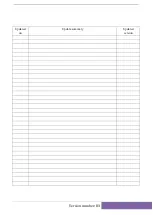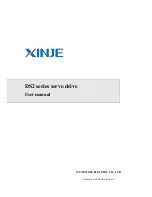
SRV-63 series AC servo drives Running and operation
-65-
Hereunder only some necessary parameters are listed:
1) Mode setting
The control mode (position mode, speed mode, torque mode, fully-closed loop mode or other
compound control mode) can be set through setting parameter P0.03 according to the control
requirements on the site. The mode will be valid after repowering on.
2) Command input
Set or enter relevant commands to control the position, speed or torque of the servo motor’s shaft
according to the setting of parameter P0.03.
In the position, fully-closed loop mode: pulse command (3 kinds of input mode), internal torque
limit command or external analog torque limit command;
In the speed mode: internal speed command or external analog speed command, internal torque
limit command or external analog torque limit command;
In the torque mode: internal torque command or external analog torque command, internal
speed limit command or external analog speed limit command.
5.1.7 Servo enabling
Enable the servo via the external servo enabling terminal (SON) or internal servo enabling parameter
(P0.04). See the function description of terminal SON and detailed explanation of parameter P0.04.
When servo enabling:
If no alarm occurs, the panel will display the default monitoring parameters;
The fan starts to run;
In position, fully-closed loop mode, if there is no pulse command input, the servo is in locked
state;
In the speed mode, the servo motor runs at the given speed;
In the torque mode, if no torque is applied externally, the servo motor accelerates from zero
speed to the limit speed. If the external torque is larger than the internal setting one, the servo
motor maintains the state of zero speed output;
If a servo alarm occurs, the panel will display ErXX-X and flicker and the servo motor will get into
the inertia running state.
5.1.8 Servo stop/Stop running
If the servo drive is in the following conditions, the servo motor will coast to stop or stop normally.
Coasting to stop means the drive cuts off output immediately, the mot or coasts to stop under the
action of inertia, and does not keep in locked state. Stopping means the drive outputs reverse torque
to make the motor to decelerate to zero speed and, after that, the motor is in a locked state.
When the servo enabling terminal (SON) signal is set to OFF, the servo motor will stop. Select
the stopping method through setting parameter P4.30. See description of P4.30 for details. This
process will not cause regenerative braking.
When a fault alarm occurs, the servo motor will stop. Select the stopping method of the servo
















































